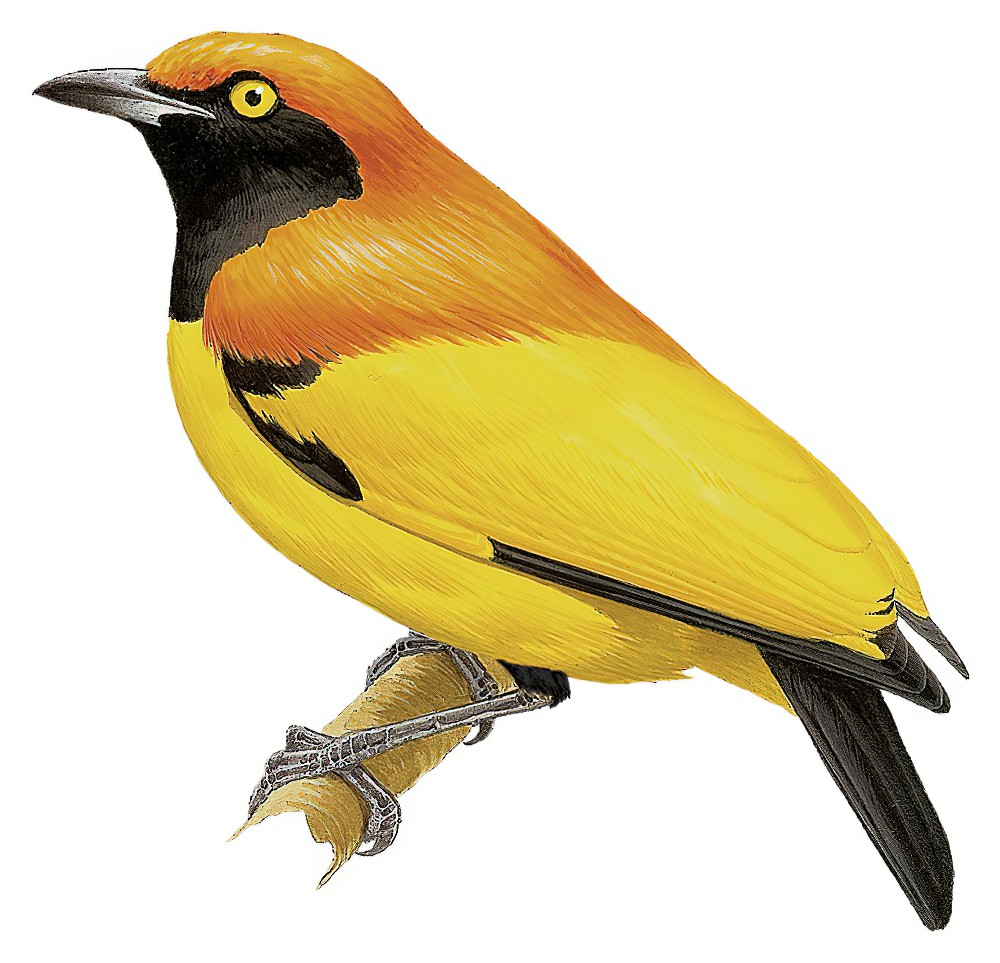Masked Bowerbird / Sericulus aureus

Masked Bowerbird
SCI Name:
Protonym: Coracias aurea Syst.Nat.ed.10 p.108
Taxonomy: Passeriformes / Ptilonorhynchidae / Sericulus
Taxonomy Code: flabow3
Type Locality: 'Asia'', error for Vogelkop, northwestern New Guinea (restricted type locality).
Author: Linnaeus
Publish Year: 1758
IUCN Status: Least Concern
DEFINITIONS
SERICULUS
(Ptilonorhynchidae; Ϯ Regent Bowerbird S. chrysocephalus) Dim. < Gr. σηρικον sērikon silk < Σηρες Sēres the people from whom silk was obtained, the Chinese; "Genus. SERICULUS. Mihi. Rostrum Orioli rostro simile. Tarsi elongati, validi. Cauda subfurcata. ... That Sericulus presents a type of form, totally distinct from all other known birds, cannot I think be questioned; it has the bill of a frugivorous bird, without even the slightest indication of those weak bristles or hairs which, in the Thrushes, are situated on each side of the rictus. The size and shape of its bill, in fact, is that of a genuine Oriole; the resemblance extends to the nares, and even to the proportional length of the wing and quill feathers: but the tarsi put on quite a distinct form; and by their lengthened, robust structure, give us every reason to suppose that the habits of the bird assimilate to those of the Merulidæ which seek their food, not only among trees, but upon the ground. We are struck by another anomaly in the tail, which, unlike that of any birds in the last two mentioned groups, is slightly though distinctly forked; this structure we generally find is indicative of a superiority of flight; and is quite unknown to me in any species of Oriolus, Turdus, or Meliphaga. From a consideration of the above characters, and arguing from theory, I should therefore say that Sericulus would indicate that passage between the true Orioles and the Merulidæ, which at present appears undiscovered; and that its habits and economy may consequently assimilate to both these groups. ... All we can say is, that if Sericulus belongs to the circle of Meliphagidæ, it presents a most singular deviation from the general structure of all those birds which are known to be nectiferous. ... SERICULUS chrysocephalus. ... King Honeysucker, Lewin's Birds of New Holland, Pl. 1. ... Front, crown, and upper part of the neck, covered by soft, close-set feathers, of a brilliant golden yellow; those on the head very short, and resembling velvet: this patch of colour borders the ears, and terminates in a half collar round the back of the neck. On the wing, is also a large spot of pure yellow, which covers the scapulars, and leaves only a black tip to the lesser quills" (Swainson 1825); "Sericulus Swainson, 1825, Zool. Journ., 1 (4), p. 476. Type, by monotypy, Meliphaga chrysocephalus Lewin." (Mayr in Peters 1962, XV, 177).
Synon. Xanthomelus.
aureus
L. aureus golden < aurum gold.
● ex “Golden-backed Finch” of Brown 1776, and “Gold-backed Grosbeak” of Latham 1783 (Euplectes).
● ex “Vultur aureus” and “Vultur Bæticus” of Ray 1713, “Vautour doré” of Brisson 1760, and “Vultur aureus” of S. Gmelin, 1774-1784 (subsp. Gypaetus barbatus).
● ex “Coq-de-Roche” of d’Aubenton 1765-1781, pl. 39, Pipra rupicola J. Gmelin, 1789, and “Rock Manakin” of Latham 1802 (syn. Rupicola rupicola).
● "49. CORACIAS. ... aurea. 5. C. flavo-fulva, gula tectricibus primariis extremitateque rectricum nigris. Paradisea flavo-fulva. Mus. Ad. Fr. I. p. 15. Paradisea aurea. Edw. Av. 112. t. 112. Habitat in Asia." (Linnaeus 1758) (Sericulus).
UPPERCASE: current genus
Uppercase first letter: generic synonym
● and ● See: generic homonyms
lowercase: species and subspecies
●: early names, variants, mispellings
‡: extinct
†: type species
Gr.: ancient Greek
L.: Latin
<: derived from
syn: synonym of
/: separates historical and modern geographic names
ex: based on
TL: type locality
OD: original diagnosis (genus) or original description (species)












